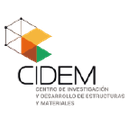Executive Secretary

IX International Symposium on Chemistry and Pharmaceutical Sciences
SIQF 2025
8th Conference “Chemical Sciences”
Problem: Alzheimer's disease (AD) is a neurodegenerative disorder characterized by the formation of senile plaques composed of amyloid-β (Aβ) aggregates in the brain, which are considered as key biomarkers for early diagnosis of this disease. Currently, early diagnostic strategies are being investigated to image and identify these plaques noninvasively. Among them, Magnetic Resonance Imaging (MRI) stands out as a promising diagnosis tool, especially when combined with contrast agents designed to specifically recognize (Aβ) deposits.
Objective: This work aims to develop two gadolinium(III)-based systems as MRI contrast agents, which can improve diagnostic accuracy.
Methodology: The first system consisted of gadolinium oxide nanoparticles (Gd₂O₃NPs) synthesized by a solvothermal method in a polyol medium, which were functionalized with PEG- diCOOH1200 to allow subsequent conjugation with Amylovis, a ligand with high affinity for Aβ plaques. The second system used stellate mesoporous silica nanoparticles (STMS NPs), obtained by the sol-gel method, and modified with APTES to facilitate the incorporation of the Gd-DOTA complex and the same functional polymer PEG-diCOOH1200. The design of both systems has been optimized and they were characterized using Infrared Spectroscopy (FTIR), Transmission Electron Microscopy (TEM), and Dynamic Light Scattering (DLS).
Results and discussion: The Gd₂O₃NPs exhibited hydrodynamic diameter in the range 145-193 nm and spectroscopic techniques evidenced the presence of Gd-O bonds and of PEG-diCOOH1200 on the NP surface. For STMS@APTES, analyses confirmed the effective surface functionalization, essential for future conjugations.
Conclusions: The results indicate that both systems have promising for Alzheimer’s disease diagnosis, although synthesis conditions need to be optimized to improve their reproducibility and stability.
Problemática: La enfermedad de Alzheimer es un trastorno neurodegenerativo caracterizado por la formación de placas seniles compuestas por agregados de β-amiloide (Aβ) en el cerebro, las cuales se consideran biomarcadores clave para el diagnóstico temprano de esta enfermedad. Actualmente, se investigan estrategias de diagnóstico temprano para visualizar e identificar estas placas de forma no invasiva. Entre ellas, la Resonancia Magnética (RM) destaca como una herramienta diagnóstica prometedora, especialmente cuando se combina con agentes de contraste diseñados para reconocer específicamente los depósitos de (Aβ).
Objetivo: Este trabajo tiene como objetivo desarrollar dos sistemas basados en gadolinio(III) como agentes de contraste para RM, que puedan mejorar la precisión diagnóstica.
Metodología: El primer sistema consistió en nanopartículas de óxido de gadolinio (Gd₂O₃NPs) sintetizadas por un método solvotérmico en un medio de poliol, que se funcionalizaron con PEG-diCOOH1200 para permitir la conjugación posterior con Amylovis, un ligando con alta afinidad por las placas de Aβ. El segundo sistema utilizó nanopartículas de sílice mesoporosas estrelladas (STMS NPs), obtenidas por el método sol-gel, y modificadas con APTES para facilitar la incorporación del complejo Gd-DOTA y el mismo polímero funcional PEG-diCOOH1200. El diseño de ambos sistemas ha sido optimizado y caracterizado mediante Espectroscopía Infrarroja (FTIR), Microscopía Electrónica de Transmisión (TEM), y Dispersión Dinámica de Luz (DLS).
Resultados y discusión: Las de Gd₂O₃NPs exhibieron un diámetro hidrodinámico en el rango de 145-193 nm y las técnicas espectroscópicas evidenciaron la presencia de enlaces Gd-O y de PEG-diCOOH1200 en la superficie de las NPs. Para STMS@APTES, los análisis confirmaron la funcionalización superficial efectiva, esencial para futuras conjugaciones.
Conclusiones: Los resultados indican que ambos sistemas son prometedores para el diagnóstico de la enfermedad de Alzheimer, aunque es necesario optimizar las condiciones de síntesis para mejorar su reproducibilidad y estabilidad.
About The Speaker

Claudia Natalí Jeréz Zamora

Discussion


 Gold
Gold
 Gold
Gold
 Silver
Silver
 Silver
Silver